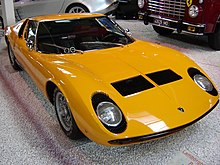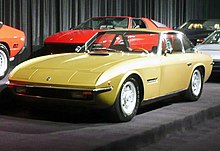1965–1966
In 1965, Gian Paolo Dallara made improvements to the Bizzarrini V12, increasing its displacement to 3.9 litres, and its power output to 320 bhp at 6,500 rpm. The engine was first installed in the 400GT, essentially a 350GT with the larger engine. At the 1966 Geneva Auto Show, Lamborghini debuted the 400GT 2+2, a stretched revision of the 350GT/400GT that featured 2+2 seating and other minor updates. The 400GT 2+2, like its predecessors, was well-received by the motoring press. The revenue from sales of the 2+2 allowed Lamborghini to increase the labour force at his factory to 170 employees, and expand services offered to Lamborghini customers.
During 1965, Dallara, Stanzani, and Wallace invested their personal time into the development of a prototype car that they envisioned as a road car with racing pedigree, capable of winning on the track as well as being driven on the road by enthusiasts. They hoped to eventually sway Ferruccio Lamborghini away from the opinion that such a car would be too expensive and distract from the company's focus. When finally brought aboard, Lamborghini allowed his engineers to go ahead, deciding that the car, known as the P400, would be useful as a potential marketing tool, if nothing more.
The car's rolling chassis, featuring an unusual-for-Lamborghini transversely mounted mid-engine layout, was displayed at the Turin Salon in 1965, impressing showgoers. A version with bodywork styled by Bertone was finished only days before its debut at the 1966 Geneva motor show. As had happened three years earlier at the debut of the 350GTV, an ill-fitting engine meant the prototype's engine bay was filled with ballast, and the hood kept locked. The favorable reaction to the P400 at Geneva led Lamborghini to slate the car for production by 1967, under the name Miura. The Miura's layout and styling would become the standard for mid-engine two-seat high-performance sports cars, a trend that continues today.
Lamborghini now had an offering that positioned the fledgling automaker as a leader in the world of supercars, while the 400GT was the sophisticated road car that Ferruccio Lamborghini had long desired to build. By end of 1966, the workforce at the Sant'Agata factory had expanded to 300, and enough deposits were made by prospective buyers to begin final development on the Miura in 1967. The first four cars produced were kept at the factory, where Bob Wallace continued to improve and refine the car. By December, 108 cars had been delivered.
1967–1968
Production of the 400GT continued, with Ferruccio Lamborghini seeking to replace the four-year-old design. Lamborghini commissioned Touring, which had styled the 350GT and original 400GT, to design a possible replacement based on the same chassis. Touring's 400 GT Flying Star II did not win Lamborghini's approval. Giorgio Neri and Luciano Bonacini, of Neri and Bonacini coachbuilders in Modena produced their own design, the 400GT Monza, which was rejected as well. Facing mounting financial difficulties, Touring would close its doors later that year.
Ferruccio Lamborghini turned to Bertone designer Mario Marazzi, who had formerly worked at Touring. Together with Lamborghini's engineers, he created a four-seater named the Marzal. The car rode on a stretched Miura chassis, and was powered by an in-line six-cylinder that was made from one-half of Lamborghini's V12 design. Despite an innovative design that featured gullwing doors and enormous glass windows, Lamborghini rejected the design. Eventually, a toned-down version became the Islero 400GT. While the car was not the full four-seater that he desired, Ferruccio Lamborghini thought the car represented a well-developed gran turismo product. It failed to attract buyers, with only 125 cars produced between 1968 and 1969.
New versions of the Miura arrived in 1968; the Miura P400 S (more commonly known as the Miura S) featured a stiffened chassis and more power, with the V12 developing 370 bhp at 7000 rpm. At the 1968 Brussels auto show, the automaker unveiled the Miura P400 Roadster (more commonly the Miura Spider), an open-top version of the coupé. Gandini, by now effectively the head of design at Bertone, had paid great attention to the details, particularly the problems of wind buffeting and noise insulation inherent to a roadster. For all of Gandini's hard work, Sgarzi was forced to turn potential buyers away, as Lamborghini and Bertone were unable to reach a consensus on the size of a theoretical roadster production run. The Miura Spider was sold off to an American metal alloy supplier, who wanted to use it as a marketing device. 1968 was a positive time for all of Ferruccio's businesses, and Automobili delivered 353 cars over the course of the year.



0 nhận xét:
Post a Comment